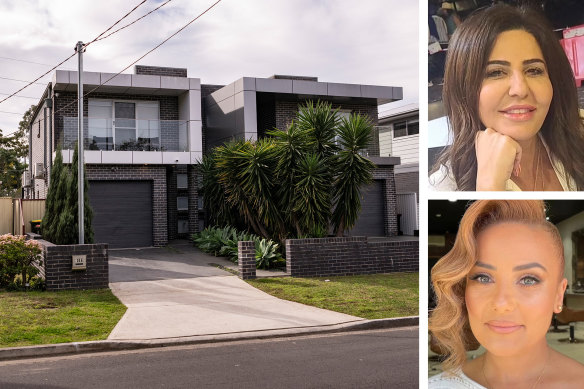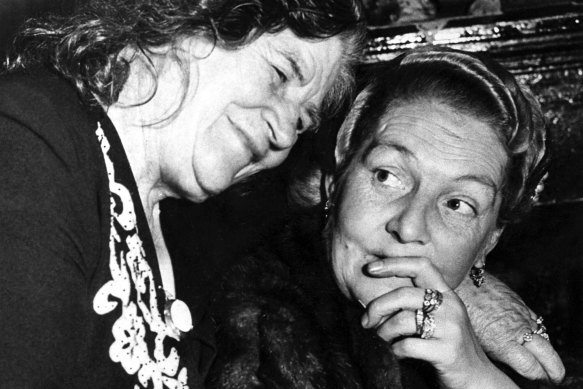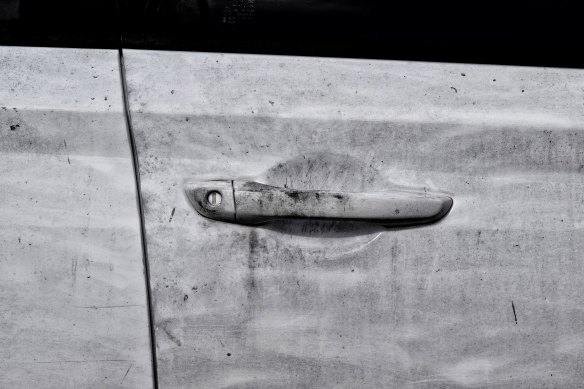This was published 2 years ago
Girls, guns and gangs: What women are up to in the underworld
By Sally Rawsthorne and Jenny Noyes
It was, homicide boss Detective Superintendent Danny Doherty said, a murder without precedent.
Last weekend on Saturday night, hairdresser Amy Hazouri, 39, blow-dried her client Lametta Fadlallah’s hair at the Panania rental property Fadlallah, 48, shared with one of her two sons. The pair planned to go together to celebrate an engagement party at a South Strathfield restaurant owned by Fadlallah’s boyfriend’s two sons. They had just slid into the backseat of a Mercedes driven by a friend of Hazouri when at least two gunmen approached the luxury car and unloaded.

The scene of the double fatal shooting of Lametta Fadlallah and Amneh “Amy” Hazouri.Credit: Wolter Peeters
Fadlallah, who detectives say was the target of the attack, died at the scene, while Hazouri died of her injuries a short time later at Liverpool Hospital.
Investigators believe she was collateral damage in the attack on Fadlallah.
Doherty’s suggestion the crime was unprecedented did not stem from its brutality – Sydney’s underworld has long favoured drive-by shootings, typically followed by the torching of stolen luxury cars.
Nor was it particularly unusual in the death of what police say was an innocent person in the wrong place at the wrong time – last year, 64-year-old Sydney tradesman Toufik Hamzy was shot by killers police believe were targeting his teenage son Salim. Other gangland shootings in the past few years have seen a nurse at Auburn Hospital struck – she survived – and a childcare centre peppered with bullets.
Rather, the double homicide shocked police and the public alike because the two victims were women.
“This is an organised, planned, methodical murder. These are the hallmarks of organised murder; we can’t get away from the fact it’s unusual and unprecedented to see two women lose their lives in this fashion,” Doherty told reporters on Sunday morning.
“It used to be an unwritten law, especially in organised crime, that you don’t touch family, and you don’t touch women. I think that rule of engagement has been thrown out the window, it’s disregarded now. I think they just don’t care any more, they don’t discriminate if you’re male or female,” he said.
The shooting has police and observers puzzling over why Fadlallah warranted an organised hit and how deeply she was involved with the criminal underworld. Was her death simply the product of the company she kept? Or was she a player? Have the rules towards women changed or was she a woman who stepped outside the usual rules for women associated with organised crime?

Sydney underworld figure Tilly Devine right with her former rival Kate Leigh in 1948.Credit: Sun News
Two of Sydney’s best known organised crime figures have been women – the infamous Tilly Devine, and her fierce competitor Kate Leigh.
The two women were not garden-variety criminals, but the city’s foremost crime figures during the 1920s and start of the 1930s, according to author Larry Writer who wrote about the duo in his book Razor, which formed the basis of Underbelly: Razor, a drama broadcast on Nine, the publisher of this newspaper.
“They were criminal masterminds,” he told The Sun-Herald.
“They had gangs that did their bidding. They were running the equivalent of million-dollar enterprises in brothels, sly grog [the unlicensed sale of alcohol] and various criminal enterprises.”
A number of murders were committed at the behest of the two women, Writer said.
The duo managed to make their way in the patriarchal world of 1920s Sydney underworld by being “more ruthless and smarter than the men”, Writer said.
“They were also very intimidating, they overcame obstacles through sheer willpower.”
In the intervening 100 years, no woman has been as prominent in the criminal life of the city as Devine or Leigh, but that doesn’t mean women have not played a significant role in organised crime.
Historically, organised crime has been “a very patriarchal thing” linked to traditional extended family values and structures, where a strong male figure looks after a larger group of families, former NSW detective and criminology associate professor Dr Michael Kennedy told The Sun-Herald.
Outsiders often incorrectly perceived the women in these groups as powerless or subservient, he said. But women involved in crime families or organisations could be “up to their necks” in the business and were even permitted to dabble in their own ventures as long as those didn’t become a liability to the larger enterprise.

Fingerprint dust covers a car in Hendy Avenue, Panania, where Lametta Fadlallah was shot.Credit: Nick Moir
These women tended to keep a lower profile and attract less police attention than their male counterparts, he said.
One senior officer said women associated with crime gangs were not naive: “They aren’t out there doing drive-bys, but they know what’s going on.
“It’s rare that they are the top of the tree, but they are certainly fair game if they are.”
At times, women have got their hands very dirty.
As a gangland war raged in the city’s south-west between the Bankstown and Blacktown chapters of the notorious Brothers 4 Life gang a decade ago, a Sydney paralegal with no criminal background began dating a high-profile gang member while he was imprisoned inside Goulburn’s high-security Supermax.
The woman, who cannot be identified except by the court-appointed pseudonym of Witness M, went on to become a highly ranked gang figure.
Aged 32, Witness M drove a getaway car from one gangland hit and one attempted murder in 2013. She later pleaded guilty to one count of being an accessory before the fact of murder and being an accessory before the fact to discharging a firearm with the intent to cause grievous bodily harm.
Earlier this month, gangland widow and organised crime figure in her own right Roberta Williams pleaded guilty to blackmailing and recklessly injuring a TV producer in Melbourne.
Women have also found themselves in the firing line before Fadlallah’s murder. As the Brothers 4 Life’s two chapters fought against one another, one woman, Lola Hamzy, was shot through the front door of her western Sydney home. The 2014 crime remains unsolved. The year prior, Maha Hamze, was shot at 21 times with eight bullets hitting her in the legs as a result of a dispute over money between her relative and another man.
Kennedy believes that Fadlallah had “become a liability for one or a number of reasons”. Since her death, the underworld has begun to speculate she was cooperating with law enforcement. “In this area, everyone’s always suspicious of everyone else. If people have been getting arrested around her, there’d be questions being asked”.
A senior detective speaking to the Herald last week was prepared to venture that Fadlallah was “that rarest of Sydney gangsters – a woman”.
Fadlallah’s mother described her last week as not a gangster but “the life of the party” – something Kennedy thinks could have contributed to her demise.
He told The Australian: “It might be OK to be the life of the party in Hollywood but not if you’re part of an organised crime structure, where you want to keep a low profile.”
Fadlallah had become known to police through her two marriages – she was married to former Telopea Street gang member Shadi Derbas, who was sentenced to five years imprisonment for tampering with evidence in a murder, then later married the late Kings Cross standover man Helal Safi.
“The 48-year-old is known to police, has a history of having associations and relationships with other identities that are known to police. Because of that, one theory is that she would have been more than likely the intended target. The 39-year-old woman sitting next to her is an innocent party in all of this,” the Homicide Squad’s Doherty said.
While Fadlallah had a limited criminal record, there are suggestions she was involved in the sale of drugs. Investigators are pursuing that, as well as a past romantic relationship gone awry or being in serious debt, as key lines of inquiry in the large-scale investigation that will see officers interview dozens of witnesses, comb over months worth of CCTV footage and speak at length to sources within the underworld.
“We’ve got multiple crime scenes, retrieved many forensic exhibits, including vehicles and ammunition,” NSW Police Commissioner Karen Webb said on Thursday.
“It’s really only early days and too early to speculate about cause, motive, anything.
“They all take time, unfortunately. I wish it was CSI and it went very quickly, but it doesn’t. That’s just reality,” she said.
The Morning Edition newsletter is our guide to the day’s most important and interesting stories, analysis and insights. Sign up here.